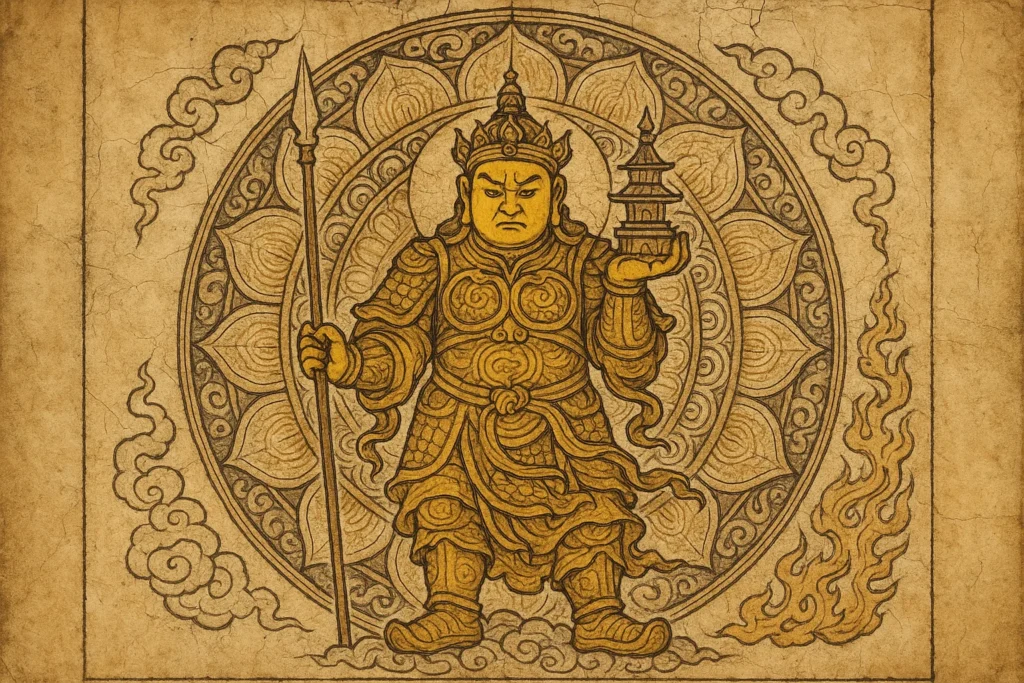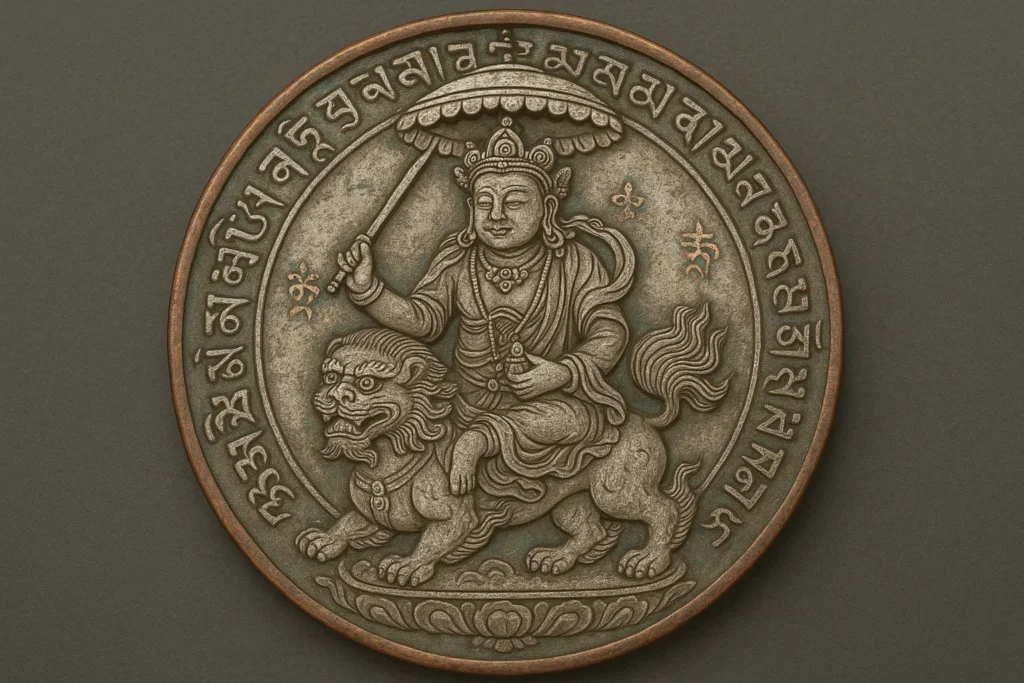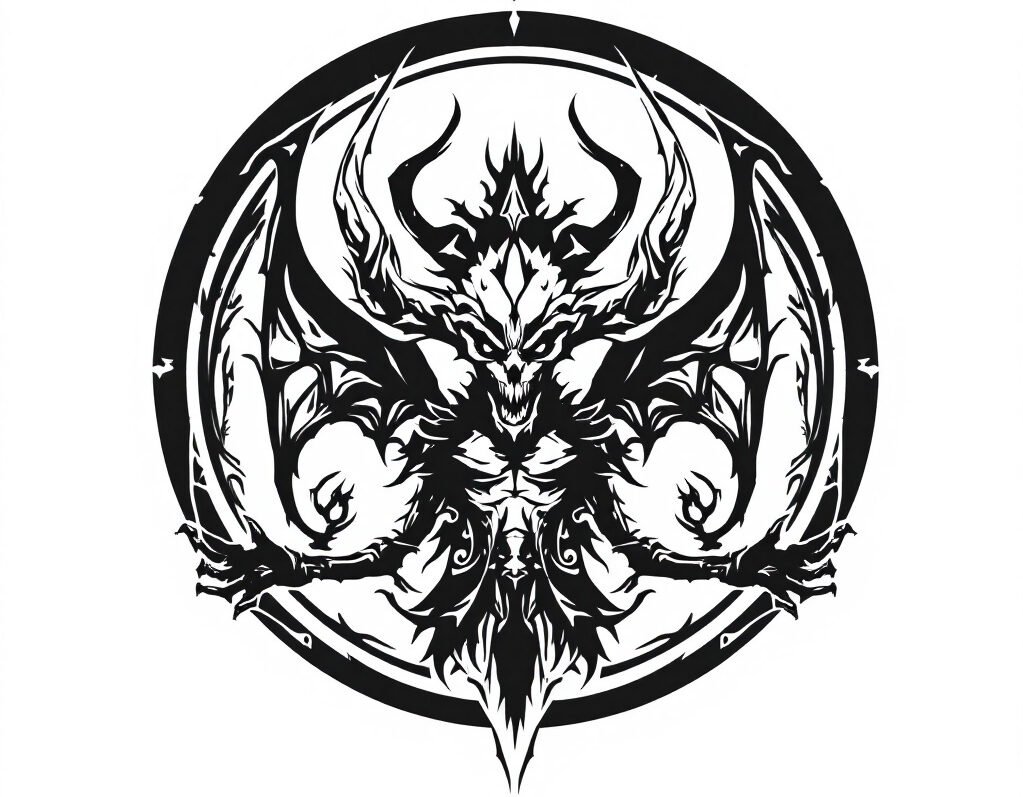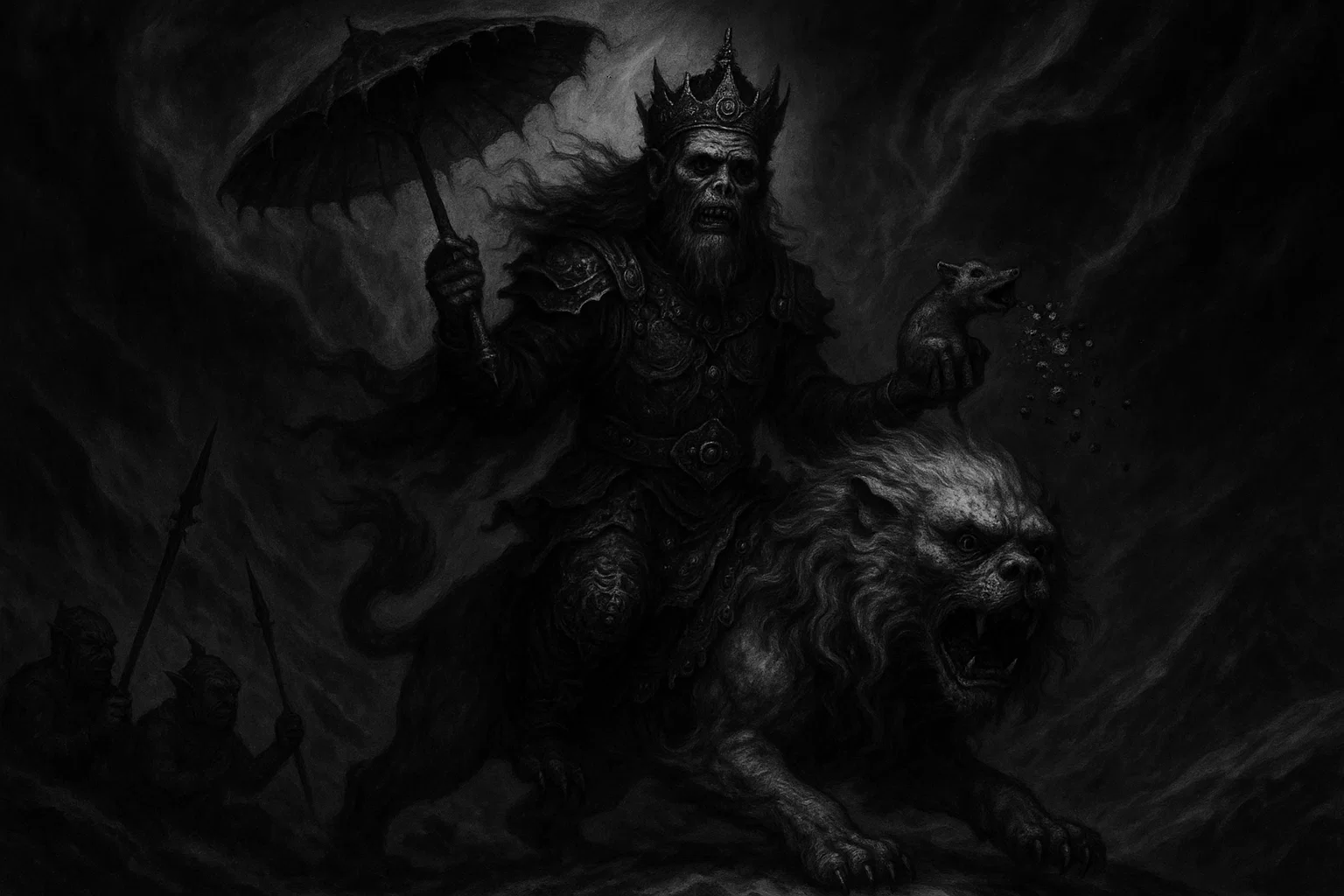Vaisravana is a key figure in Buddhist traditions. He serves as one of the Four Heavenly Kings who protect the world from harm. Known for guarding the north, he leads spirits called yakshas and fights against evil forces.
People typically view him as a source of wealth and security, often turning to him for help in times of need. His role focuses on keeping balance in the universe and aiding those who follow Buddhist teachings.
This entity also appears in Hindu stories as Kubera, the god of wealth and prosperity. You can check the Hindu Demons category for more details on that side.
Summary
Key Takeaways
| Attribute | Details |
|---|---|
| Names | Vaiśravaṇa (Sanskrit), Vessavaṇa (Pali), Namtösé (Tibetan), Duōwén Tiānwáng (Chinese), Bishamonten (Japanese), Damun-cheonwang (Korean), Thao Wetsuwan (Thai), Kuwera Nat Min (Burmese). |
| Title | Guardian of the North, Chief of the Four Heavenly Kings, God of Wealth, Leader of Yakshas. |
| Region | India, Tibet, China, Japan, Korea, Thailand, Mongolia. |
| Type | Buddhist deity, Dharmapala, Yaksha king. |
| Gender | Male. |
| Realm | Cātummahārājikā heaven (Desire realm). |
| Obstacle/Threat | None. |
| Associated Figures | Buddha, other Heavenly Kings (Dhṛtarāṣṭra, Virūḍhaka, Virūpākṣa), Ratnasambhava. |
| Weapon/Item | Umbrella (parasol), mongoose, pagoda, spear, trident, club. |
| Weaknesses | Mortal lifespan as a deva; replaced upon death. |
| Associated Deity/Figure | Gautama Buddha. |
| Pantheon | Buddhist with Hindu influences. |
| Primary Sources | Āṭānāṭiya Sutta, Janavasabha Sutta, Sutra of Golden Light, Lotus Sutra. |
“Vaisravana” Meaning
The name “Vaisravana” comes from Sanskrit roots. It links to “vi-śru,” which means “to hear clearly” or “become well-known.” As a longer form, it acts like a family name tied to fame or listening.
In ancient texts, it is associated with Viśravaṇa, meaning “son of Vishrava”—a wise figure in the stories. This ties him to Kubera in Hindu tales, where he rules over riches hidden in the earth.
Over time, the name changed across areas. In Pali, it became Vessavaṇa, keeping the idea of “hearing much.” The Chinese call him Duōwén Tiānwáng, or “he who hears everything.” This illustrates his role in overseeing the world and responding to pleas for help.
In Japan, Bishamonten retains the sound but incorporates ideas of war and safety. The Tibetan Namtösé means “son who hears all,” fitting his role as a guardian.
Korean Damun-cheonwang follows the Chinese style, stressing his wide knowledge. Thai Thao Wetsuwan honors him as a leader. These shifts demonstrate how Buddhism spread, incorporating local words into its core meanings. From a spirit in early Indian lore to a king in East Asia, the name grew to fit new roles. Yet, it always points to awareness and wealth.
How to Pronounce “Vaisravana” in English
Say it as “v-eye-shra-vah-na.” Break it down: “vai” like “vie,” “śra” like “shra,” “va” like “vah,” “ṇa” like “na.”
In Chinese, Duōwén Tiānwáng is “dwo-wen tyen-wahng.”
Japanese Bishamonten is “bee-sha-mon-ten.”
Korean Damun-cheonwang is “da-moon-chun-wahng.”
What Does Vaisravana Look Like?
Vaisravana appears as a strong warrior in armor, ready for battle. His face often shows yellow, a sign of his link to the north. On one hand, he holds an umbrella or parasol—this symbolizes his rule and power.
On the other hand, a mongoose might grip a mongoose, which spits out gems to show giving and beating greed. Sometimes, he carries a small tower or pagoda, guarding hidden treasures.
In Indian and Theravada art, he appears tall and firm, wearing simple clothes beneath his armor. A club serves as his tool, from early days when he led spirits.
Tibetan styles make him rounder, covered in jewels, sitting with one foot down on a lotus. His ride is a snow lion, fierce and white. He might hold a fruit called citron, tied to his wealth side.
Chinese pictures depict him holding a three-point spear in his left hand and a tower in his right. His armor shines, and he stands in halls with other kings.
Japanese Bishamonten holds a spear and a pagoda, appearing as a warrior against wrongdoers.
Korean versions follow Chinese but incorporate local touches, such as softer lines.
You may also enjoy:
Who Is Agaliarept, the General of Hell Under Lucifer?
October 8, 2025
What Is Qarin and Why Does It Follow Every Human Being?
October 8, 2025
Who Was Abezethibou, the Fallen Angel Who Opposed Moses?
October 1, 2025
Si’la: The Seductive Jinn Who Lures Travelers to Their Doom
October 9, 2025
Who Is Abalam in Demonology? The Terrifying King That Serves Paimon
September 30, 2025
Abura-akago: The Oil-Licking Demon Baby
October 22, 2025
Origins
Vaisravana first appears in ancient Indian tales as a spirit hiding in earth cracks. He starts as a leader of yakshas—beings similar to fairies or ogres.
Over time, he turns kinder, guarding treasures and the north. His connection to Kubera in Hindu lore is associated with wealth. In early Buddhist texts, he becomes Vessavaṇa, one of the Four Great Kings.
The Pali Canon tells his past life story. As a wealthy mill owner in Sri Lanka, he provided food from his mill to the poor for many years. This good act led to his birth in Heaven as Vessavaṇa. He rules the northern part of the world, including a rich land called Uttarakuru. His city, Ālakamandā, is beautiful and rich.
In later stories, he joined the guards of Mount Sumeru. He also leads a group of yakshas to protect the law. In Mahayana ways, he vows to shield rulers and followers.
Crossovers from Hindu roots add layers, such as his family ties—his wife, Bhuñjatī, five daughters, and nephew, Puṇṇaka.
His role expands even further in East Asia. In China, he becomes a war god. Japan sees him as a punisher of bad acts. Tibet views him as part of Ratnasambhava’s group.
Regional Variations
The way this Buddhist entity is viewed varies from one region to another, reflecting local needs and artistic styles. In some places, he serves as a guardian; in others, he bestows wealth.
| Region/Tradition | Appearance | Role |
|---|---|---|
| Theravada (Thailand, Sri Lanka) | Tall warrior, yellow face, holding club or parasol, simple armor. | Guardian of north, protector from spirits. |
| Mahayana (China) | Armored with trident and pagoda, green or yellow skin, fierce eyes. | Warrior god, protects dharma and state. |
| Vajrayana (Tibet) | Corpulent, jewel-covered, seated on snow lion, mongoose in hand. | Wealth deity, part of buddha retinue. |
| Mahayana (Japan) | Spear and pagoda, heavy armor, standing pose. | God of warriors, punisher of evil. |
| Mahayana (Korea) | Similar to Chinese, softer features, tower in hand. | Guardian king, brings fortune. |

Buddhist Cosmology
Vaisravana holds a spot in the Realm of Desire, at the base of Mount Sumeru. He rules the north side of the Four Kings’ Heaven (called Cātummahārājikā). This place sits above human lands but below the higher gods.
As the chief king, he watches over yakshas and reports on people’s good and bad acts to the upper assemblies. His job keeps order, stopping Asuras from causing trouble.
Vaisravana in the Pali Canon
In early texts, Vaisravana is typically mentioned as a guardian. He follows the Buddha and shields his followers from wild spirits.
| Source | Quote |
|---|---|
| Āṭānāṭiya Sutta (DN 32) | Thus have I heard. On one occasion the Blessed One was dwelling at Rajagaha on Mount Vulture Peak. Then, when the night had advanced far, the Four Great Kings with a large army of yakkhas, with a large army of gandhabbas, with a large army of kumbhandas, with a large army of nagas, having approached Mount Vulture Peak from the four quarters, illuminating it entirely, saluted the Blessed One and sat down to one side. Then those yakkhas who had come saluted the Blessed One and some sat down to one side, some exchanged courteous greetings with the Blessed One and, having done so, sat down to one side, some saluted him with joined palms and sat down to one side, some announced their name and clan and sat down to one side, while still others remained silent and sat down to one side. Then Vessavana the Great King, while sitting to one side, said to the Blessed One: ‘Bhante, there are eminent yakkhas who do not have confidence in the Blessed One. There are also eminent yakkhas who have confidence in the Blessed One. And there are yakkhas of middling status of both kinds… Therefore, Bhante, let the Blessed One learn the Atanatiya protective chant for the protection, shelter, and guarding of the bhikkhus, bhikkhunis, laymen followers, and laywomen followers.’ The Blessed One consented by silence. Then Vessavana the Great King, having understood the Blessed One’s consent, on that occasion recited the Atanatiya protective chant. |
| Janavasabha Sutta (DN 18) | Then King Vessavana said to a certain yakkha: ‘Dear sir, go to the yakkha Punnaka and say to him: ‘King Vessavana has summoned you, sir.’ |
Vaisravana in Mahayana Sutras
In Mahayana Sutras, Vaisravana takes on vows to protect the teachings, as later texts attest. He acts as a warrior for the law.
| Source | Quote |
|---|---|
| Sutra of Golden Light | Then the great king Vaiśravaṇa, protector of the world, addressed the Tathāgata in these verses: ‘Lord of Sages, in times of strife, degeneration and decline, when monks are abused and threatened by kings, I will constantly protect them with my yakṣa hordes… If, O Lord of Humans, a king hears this king of sublime sūtras and then protects and cares for the Saṅgha, I, the great king Vaiśravaṇa, will protect that king. |
| Lotus Sutra | At that time there were also innumerable great kings of the asuras in the gathering… Likewise the four heavenly kings were there with their followers of twenty thousand heavenly sons. Included among them were Heavenly King Dhṛtarāṣṭra, Heavenly King Virūḍhaka, Heavenly King Virūpākṣa, and Heavenly King Vaiśravaṇa. |
Powers and Abilities
Vaisravana stands tall among celestial beings, surpassing the strength of the yakshas (the spirits he commands), yet ranking beneath the illustrious gods (like Indra).
Unlike demons who thrive on deception and chaos, Vaisravana aligns himself with the forces of good, using wisdom and strategic insight to combat evil. His formidable power is on par with other kings of the divine realm, positioning him as an essential figure in the cosmic balance.
Vaisravana’s remarkable powers and abilities include:
- Command over Yakshas and Rakshasas: He skillfully leads his enchanted warriors—yakshas and rakshasas—into battle against the forces of evil, employing their great strength and cunning to uphold righteousness.
- Wealth and Liberation: Known as the granter of prosperity, Vaisravana bestows material wealth and spiritual freedom upon those who honor him, ensuring their well-being and abundance.
- Protection from Evil Spirits: Through powerful incantations and divine force, he shields his devotees from malevolent spirits, safeguarding them in both their physical and spiritual realms.
- Observer of Human Conduct: With vigilant eyes, Vaisravana monitors human actions and intentions, faithfully reporting their deeds to the celestial realms, thus maintaining the moral order of the universe.
- Control over Rain: As a deity possessing dominion over the elements, he regulates rainfall essential for agriculture, fostering growth and ensuring ecological balance across the lands.
- Longevity: Vaisravana is said to live for an astounding nine million years, a testament to his divine nature and eternal essence, which endows him with continued influence in both the realm of the living and the heavens.
- Rides a Snow Lion: In battles, he rides a majestic snow lion, symbolizing strength and speed, allowing him to traverse vast landscapes quickly and engage his foes with unmatched agility.
- Counteracting Greed: He is often depicted with a mongoose, a creature known for its ability to expel greed, which represents Vaisravana’s power to diminish avarice and encourage generosity among his followers.
Vaisravana Myths, Legends, and Stories
Past Life as the Mill Owner
In ancient times, there was a wealthy man known for owning seven busy grain mills, each of which was carefully tended to. Every morning, as the sun began to rise, he would wake up early to gather the best grains from each of his mills.
With great dedication, he shared all the grain he collected that day with those who were poor and hungry, providing food and hope to the villagers without hesitation. For an incredible twenty thousand years, this kind mill owner opened his heart and his resources to everyone in need, welcoming people from far and wide who came looking for help.
His generosity was limitless; he never turned anyone away, no matter their background or situation. His acts of kindness created a wave of goodwill in his community, building up a positive legacy that he would carry with him into his next life.
When he passed away, the heavens celebrated his good deeds. He ascended to a beautiful and majestic heavenly realm called Cātummahārājikā.
In this divine place, he became Vessavana, the revered king of the north, a symbol of protection and abundance. His new name, Kuvera, reflected his past life and stood for his lifelong commitment to helping others.
Even in this grand position where he ruled over great wealth, Kuvera’s spirit of kindness remained unchanged. Just as he had done before, he continued to share the treasures of his realm, ensuring that anyone who sought his help would receive it with warmth and generosity.
His legacy of giving created a kingdom filled with prosperity, harmony, and a lasting spirit of helping one another.
Presenting the Atanata Verses to the Buddha
On a peaceful night atop Vulture Peak, the Buddha sat calmly in meditation, surrounded by his devoted followers.
The night was filled with a special energy as four powerful heavenly beings (known as the Four Great Kings) descended from the sky, bringing with them shining spirits that lit up the mountain with a warm glow. After respectfully bowing to the Buddha, they gathered in a circle around him.
Vessavana, the leader of the yakshas (spirit beings), spoke up, a hint of worry in his voice. “Lord, while some of my kind have come to trust and admire you, there are still those who mean harm. They could pose a danger to your monks as they explore the nearby woods.”
Recognizing the potential threat, Vessavana asked the Buddha to share protective words—timeless chants that would keep his followers safe from harm.
The Buddha listened carefully and agreed readily, understanding the vital importance of protecting his monks. Vessavana then recited the Atanatiya chant, a powerful prayer that called upon heavenly kings and benevolent spirits to act as guardians, shielding the monks from malevolent influences.
The air filled with the sound of the chant, each word resonating with powerful energy.
Once Vessavana finished, the Buddha turned to his monks, his eyes filled with kindness, and encouraged them to include this chant in their daily practices.
From that moment on, the sacred words of the Atanatiya served as a protective shield, helping the monks focus on their meditation with peace of mind. With the watchful presence of kind spirits around them, the monks thrived on their journey toward enlightenment, embracing the beauty of nature.

Vow in the Golden Light Sutra
The Buddha shared his important teachings, known as the Dharma, which means “the way things are.” This wisdom resonated with leaders worldwide. One of these leaders was Vaiśravaṇa, a strong protector who spoke out with great passion.
He declared, “O Sage Lord, in these difficult times when there is fighting and disagreement, and when monks are at risk from harsh rulers, I promise to protect them with my group of yakshas, powerful celestial beings.”
Vaiśravaṇa vowed to defend any land that respected and followed the Buddha’s teachings. He also mentioned that if a king showed kindness and respect to the monks, he would also receive Vaiśravaṇa’s protection.
The Buddha smiled warmly, pleased with this promise, recognizing that it gave Vaiśravaṇa an important role as a protector of his teachings.
During times of conflict, rulers sought Vaiśravaṇa’s support and guidance.
Protection in the Lotus Sutra Assembly
At a gathering of great importance, the Buddha shared his teachings, known as the Lotus Sutra, which resonated deeply with everyone present.
Among the crowd were powerful Asura kings and heavenly beings, all shining with divine qualities. The Four Heavenly Kings, who protect the four directions, sat with their respected sons, embodying the spirit of guardianship and righteousness.
Vaiśravaṇa, the revered ruler of wealth and a significant figure among the heavens, attended the assembly, eager to learn from the enlightening words being spoken.
The Buddha’s teachings illuminated the path to enlightenment, conveying that every being, regardless of their current condition, possesses the potential for awakening and growth. Inspired by this message, Vaiśravaṇa and the others pledged to share these important truths throughout their realms.
However, just as moments of enlightenment often face challenges, dark forces attempted to disrupt this sacred gathering. Determined to protect the teachings and the inspired attendees, Vaiśravaṇa bravely confronted these negative influences, driving them away with his strength and wisdom.
His unwavering dedication and courage played a key role in keeping the assembly safe and ensuring the purity of the teachings shared.
Dispute Resolution in Thai Legend
In ancient Thailand, there was a touching story about two lovers, Nang Ai and Phadaeng, whose love faced many challenges. Their strong feelings for each other became strained when they argued passionately over a piece of land that represented their dreams and hopes. This conflict created a heavy atmosphere filled with tension.
During this difficult time, a wise and respected figure from the north appeared—Vaiśravaṇa (Thao Wetsuwan), the guardian of wealth and happiness. He saw the turmoil between the couple and understood the pain it caused.
With compassion and wisdom, he spoke to the lovers, sharing words that encouraged fairness and understanding. His advice helped to ease their anger and brought them closer together.
You may also enjoy:
Abadir: The Demon Servant of Chaos and Dispersion
September 30, 2025
Who Is Adrammelech in Demonology and the Bible?
October 1, 2025
Who Was Ravana in Hindu Mythology and Why Was He Feared?
October 3, 2025
Abura-sumashi: The Potato-Headed Yōkai That Punishes Greed
October 23, 2025
Vritra: The Dragon Who Swallowed the Sky in Hindu Mythology
October 7, 2025
Si’la: The Seductive Jinn Who Lures Travelers to Their Doom
October 9, 2025
Birth of His Nephew and Family Ties
Vessavana was a respected king of the Yakshas, a mythical race known for their guardianship and wisdom. He was happily married to his dedicated wife, Bhuñjatī. Together, they had five lovely daughters, each with her own special qualities:
- Latā, who was known for her beauty and charm,
- Sajjā, who was wise and caring,
- Pavarā, who was strong and determined,
- Acchimatī, who was smart and insightful,
- Sutā, who had a kind and gentle nature.
Among their relatives was Puṇṇaka, Vessavana’s ambitious nephew, who made an important connection by marrying a naga woman, adding depth to their family ties.
Guarding the North Quadrant
On the grand slopes of Sumeru, the respected figure Vaiśravaṇa makes his home in the northern region, where his stunning city, Ālakamandā, shines with incredible wealth and prosperity.
This rich area is known as Visāṇa, named after him. Vaiśravaṇa carefully assigns specific places for the yakshas, celestial beings who are like guardians, watching over the land like calm lakes provide tranquility. From the beginning of his reign, he set up these spots with careful thought and attention.
His powerful chariot, known as Nārīvāhana, enables him to travel swiftly through various realms, embodying both speed and grandeur. In the past, he wielded a strong club that showcased his might.
However, after learning from the Buddha, he changed his approach. Instead of just relying on force, he decided to offer guidance and wisdom.
Now, he serves not only as a protector of treasures but also as a source of insight for those seeking understanding in the areas he watches over.
Conversion to Follower
When the Buddha was born, a brilliant light appeared, drawing the attention of Vessavana, the king of a mystical snake-like being known as Nagas.
This moment changed everything for Vessavana; inspired by the Buddha, he became a devoted follower and reached a significant milestone in his spiritual journey, called “sotapanna.” This means he had only seven more lifetimes to go before achieving complete enlightenment.
Vessavana’s dedication went beyond just his path. He assumed the role of a messenger between the heavenly beings and the Buddha, conveying important messages and wisdom from the gods. His commitment to Buddha’s teachings not only helped him grow spiritually but also made him a protector for those who followed the path.
Again and again, he stepped in to help followers avoid danger and bad luck, acting as a guardian on their journey to enlightenment. By doing so, Vessavana established himself as a true protector of the Dhamma, dedicated to helping others find safety and spiritual growth in their pursuit of the Buddha’s teachings.
Vaisravana vs Other Buddhist Demons
| Demon Name | Associated Obstacle/Role | Origin/Source | Key Traits/Powers |
|---|---|---|---|
| Mara | Temptation | Pali Canon | Illusions, fear inducement. |
| Yama | Death judgment | Mahayana sutras | Rules hell realms, karma enforcer. |
| Mahakala | Protection (wrathful) | Vajrayana texts | Time destroyer, fierce form. |
| Palden Lhamo | Guardian | Tibetan lore | Disease bringer, protector. |
| Rahu | Eclipse causer | Buddhist cosmology | Shadow planet, obstruction. |
| Preta | Hunger ghost | Pali Canon | Eternal thirst, suffering. |
| Asura | Jealousy warriors | Mahayana sutras | Constant battle, envy. |
| Yaksha (general) | Nature spirits | Jataka tales | Shape-shifting, treasure guards. |
| Kumbhanda | Pot-bellied demons | Pali Canon | Guard south, grotesque form. |
| Naga | Serpent beings | Mahayana sutras | Water control, sometimes harmful. |
| Vetala | Corpse possessors | Tantric texts | Undead animation, knowledge. |
| Pisaca | Flesh eaters | Buddhist folklore | Madness causer, unclean. |
| Bhuta | Ghosts | Pali Canon | Haunting, unrest. |
| Krodha | Anger deities | Vajrayana | Wrath manifestation, protection. |

Mystical Correspondences
| Attribute | Details |
|---|---|
| Planet | Venus (wealth link). |
| Zodiac Sign | Taurus (earth riches). |
| Element | Earth. |
| Direction | North. |
| Color | Yellow, green. |
| Number | 8 (directions guard). |
| Crystal/Mineral | Citrine, jade. |
| Metal | Gold. |
| Herb/Plant | Lotus. |
| Animal | Snow lion, mongoose. |
| Trait/Role | Protection, generosity. |
Vaisravana is linked to the earth for his rule. North fits his guard spot, with yellow for his face in art. The mongoose fights greed, like Venus tied to value. These help in rites for wealth or safety. People use citrine to call their giving side.
In some views, he emphasizes the importance of spirit over material things.
Vaisravana’s Items & Symbolism
Vaisravana is known for his powerful symbols. One of his main objects is a parasol, which not only serves as a shield from danger but also represents his royal authority, much like a king rules over his kingdom. This beautiful umbrella signifies safety and a safe haven for those in need.
Another fascinating item he possesses is a mongoose, which is famous for spitting out precious gems. This action symbolizes overcoming greed and emphasizes the importance of being generous and sharing wealth with others.
In some images, Vaisravana is also depicted with a pagoda, a structure that protects valuable treasures. This pagoda is believed to bring blessings to those who are worthy, representing the connection between spiritual honesty and prosperity.
Vaisravana is often depicted carrying a spear or trident, symbolizing his strength and readiness to combat evil. The spear represents his willingness to battle against wrongdoing, while the trident symbolizes his ability to handle different challenges effectively.
He may also hold a club, a symbol of his strength and determination that dates back to ancient times. This powerful weapon illustrates his dedication to defending against dangers and protecting his community.
You may also enjoy:
Rāga: The Seductive Demon of Passion and Desire in Buddhist Lore
October 16, 2025
Who Is Aka Manto, Japan’s Terrifying Red-Cloaked Yōkai?
October 24, 2025
Vaisravana: The Golden Guardian King Who Rules the North
October 16, 2025
Si’la: The Seductive Jinn Who Lures Travelers to Their Doom
October 9, 2025
Mara: The Buddhist Demon King of Desire and Death
October 13, 2025
Who Was Mahishasura, the Buffalo Demon Slain by Goddess Durga?
October 3, 2025

